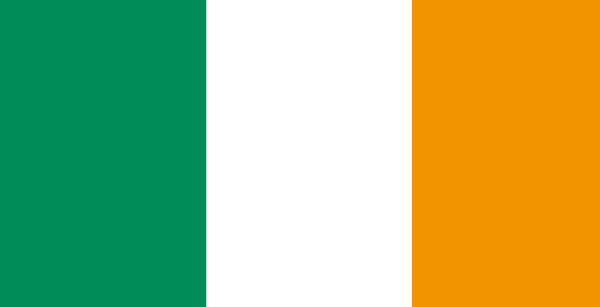Ireland, one objective: reunification

Ireland is an island situated to the extreme north-west of Europe. It is the biggest of the six Celtic countries. The largest part of the island forms an independent republic, while the north-east remains under the control of the United Kingdom.

Ireland has been a Celtic country for a long time. The Gaels succeeded the megalithic civilisations who were closely related to those living in Brittany (the site of Newgrange was connected to that of Barnenez in Brittany). Never experiencing Roman colonisation, these Gaels were able to integrate different successive waves of Britons, Vikings, Anglo-Normans etc. who adopted the Gaelic language and Celtic civilisation. The English occupation, which started in the 12th century and peaked in the 18th, relegated the natives to second class citizens and favoured the plantation of British colonies, a policy exacerbated by the issue of religion. The Irish remained attached to Catholicism, while the new residents, who held political and economical power, were Protestants.
Paradoxically, the beginnings of the Irish political movement for the liberation of the island were the work of a Protestant lawyer, Wolfe Tone, who preconceived the union of Catholics and Protestants. These days, English is the dominant language on the island, but the Celtic culture remains a mainstay of the national conscience and is kept alive and regularly reinvented.
Today, the north is still governed by the United Kingdom. The conflict intensified from the 1960s onwards, the Irish Republican Army and the Unionist paramilitary groups largely defining this period. Nowadays, while a ceasefire is in effect, complete political resolution remains to be achieved.

Identity card

| Name | Éire | Irish Gaelic Ireland | English |
| Population | 5,946,000 inhab. (United Ireland) (2006) |
| Area | 84,421 km² |
| Languages | Gaeilge | Irish Gaelic English | English (official) Scots | Scots (without official status) |
| Number of native speakers | 540,000 to 1,800,000 | Irish Gaelic |
| State of guardianship | Ireland, United Kingdom |
| Official status | Independent republic for 26 counties of 32; 6 counties of the northeast, under the name of Northern Ireland, form a province of the United Kingdom |
| Capital | Baile Átha Cliath | Irish Gaelic Dublin | English |
| Historic religion | Roman Catholic |
| Flag | An Trídhathach | Irish Gaelic The Irish Tricolour | English |
| Anthem | Amhrán na bhFiann | Irish Gaelic The Soldier’s Song | English |
| Motto | None |

Timeline

- 5th–6th century • Evangelization by St Patrick and vast cultural and religious development (Celtic Church).
- 1171 • Start of English domination which results in centuries of theft of land, “plantations” of Scottish and English Protestant colonies principally in the north-east, which sees Catholics relegated to second-class citizens.
- 1801 • Integration with the United Kingdom.
- 1846–1848 • “The Great Famine” results in misery, depopulation and mass migration.
- 1916–1922 • Uprising against British power.
- 1921 • Creation of a Free State.
- 1949 • Creation of the Republic of Ireland which covers 26 of the 32 counties of the island. Six counties of the north-east, dominated by the Unionists, remain an integrated part of the United Kingdom. Civil war between the provisional government opponents.
- 1998 • Agreement of peace on “Good Friday” which provides power sharing in Northern Ireland.

Brief history

The rising against British power began in 1916 and the war of independence, which followed in 1921, led to a treaty partitioning the island of Ireland. Twenty-six of the 32 counties formed a “Free State” becoming a republic in 1949. Six of the nine counties of Ulster, dominated by the Unionists, remained loyal to London, these Unionists refused all sharing of power with the strong nationalist minority (43%), resulting in a movement for the equality of civil rights and a guerrilla war led by the Irish Republican Army (IRA). In 1998, negotiations lead to the “Good Friday” peace agreement. Sinn Féin became the principal nationalist party and the IRA eventually disarmed in 2005. The peace process now appears to be on track with the formation of a coalition government, in spite of the opposition of many Unionists.

Geography

Ireland is the third largest island in Europe. It lies to the north-west and enjoys a pronounced oceanic and temperate climate. A vast central bog land, dotted with numerous lakes and traversed by the Shannon, is surrounded by several hills and highlands (highest point: Carrauntoohill, 1,041 m). It is traditionally divided into four provinces (Munster, Connacht, Leinster and Ulster). Northern Ireland remains under British control. The economy of the island has for a long time depended on agriculture, with the north-east being the most industrialised. In the past, the country was an important ground for emigration. For a few decades and particularly since its entry into the European Union, this tendency has been reversed and the country became one of the wealthiest in the world before the global economic crisis struck (4th in the 2005 world rankings for PIB per capita at purchasing power), earning it the nickname “The Celtic Tiger”.



Language

Gaeilge
Irish (or Gaeilge) is a Celtic language of the Goidelic group, like Scottish Gaelic. It is the first official language of the Republic of Ireland (since 1921) and became an official language of the European Union in 2007. Its usage has declined a great deal in its traditional strongholds in the west (Gaeltachtaí), but progressed in the towns, education and in the diverse aspects of modern life. Spoken by more than 1.2 million people, Irish is a daily language of 70,000 people. Thanks to efforts put in place by the Irish government and the Official Languages Act 2003, Irish and English have been placed on equal footing. For example, the television channel TG4 (formerly Teilifís na Gaeilge) broadcasts programmes in Irish. Despite these efforts, the Irish have a paradoxical attitude to their language and generally prefer to use English, the international language. Irish is thus in a critical situation.

Politics now

The principal political problem remains the situation in Northern Ireland. Although the Republic of Ireland is run on a Western democratic model (even if it struggles to return the Irish language back to the place it deserves), the north is still only at the start of a process that could lead to a government representing all segments of the population. The rediscovery of the north by the south has encouraged a more positive and evolutionary solution to the problem, based on peace and social progress. This process began in 1995 through an agreement signed between Dublin and London on the management of affairs in the north and the Good Friday Agreement in 1998.
Representative Irish separatist parties
- Sinn Féin (Nationalist and Republican)
- Social Democratic and Labour Party (Moderate Nationalist)

